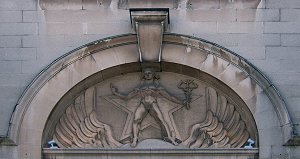|

Listing: Built as head offices
for the Express and Star in the 1930s at a time when Malcolm Graham, son of
Thomas Graham who founded the Evening Star in 1880 (merged with the Evening
Express in 1884), was "working tirelessly to drag the Express and Star into the
age of modern newspapers, gradually bringing in new production machinery,
speeding up printing times and producing a cleaner and more attractive
newspaper" (Express and Star supplement 1999 ).
The Express and
Star building consists of two wings on either side of a stone projecting
central bay. Central bay includes a rounded arch rising through three
storeys with a high level sculpture of Mercury. The east wing, also
built with stone, is a four‑storey six bay building with glazed
shopfront and channelled ashlar above with a projecting stone string
course between floors two and three. The late 20th century west wing is
not part of the locally listed building.
A plaque
commemorates R. J. Emerson, art teacher and sculptor who sculpted
Mercury in 1932. The sculpture adds to the variety of public sculptures
found on several of Wolverhampton's buildings, possibly as a result of
the influence of the Art College in Wulfruna Street.
The building is a
fine example of architecture of the period with landmark quality and a
notable public sculpture.
Literature: Peter Rhodes, The
Loaded Hour: a History of the Express and Star, S.P.A. Ltd., 1992.
pp.88 to 89
Comment: The date of the
building is 1934. The architect was Marcus Brown of Wolverhampton.
The building is faced in a reconstituted Hollington stone called
"Vinculum", produced by another local firm, Tarmac. The building
contract, for £14,000, was given to yet another local firm, Wilson
Lovatt.
 |
R. J. Emerson was a great friend of the proprietors of
the Express and Star, the Graham family, and, for
many years, actually had his studio in the building.
The figure of Mercury used the son of a local doctor as the
model; and was cast in Vinculum stone from Emerson's model. |
The listing refers to the building's "landmark
quality". Peter Rhodes records the recollection of the then
proprietor, Malcolm Graham, that the new building had a subtle effect on
those who worked in it and those who visited it to insert adverts.
"In the old days people simply came into the front office, handed in
their adverts and went away again. When the new building was
finished, they came in, removed their hats and handed in their adverts.
That was the effect it had on people. Curious ...."
The new building replaced some Georgian houses at
the front and a mish-mash of bits and pieces at the back. The loss
of this part of an otherwise pretty complete Georgian streetscape was
unfortunate but at least the replacement was a decent effort. It
is likely that the mirror image of the part to the left of the central
tower was intended to be built on the other side. Luckily for the
Georgian houses which survive on that side, this never happened, despite
the Star's rapid expansion in the 1930s.

|